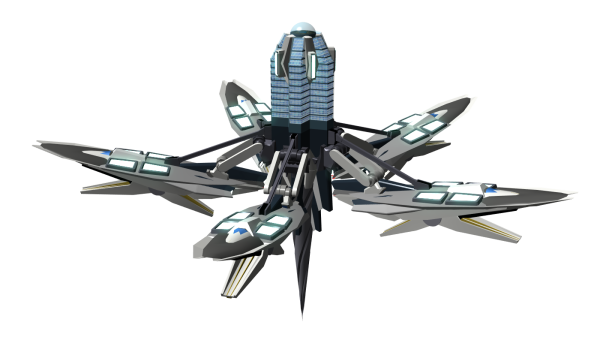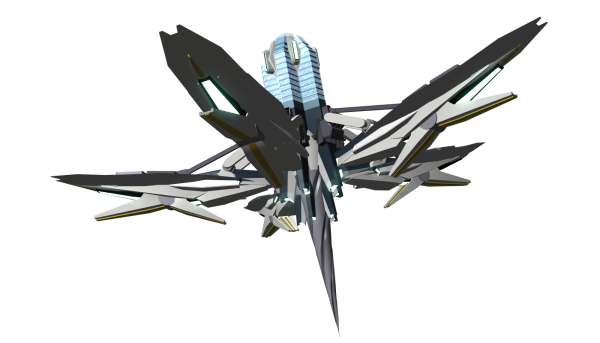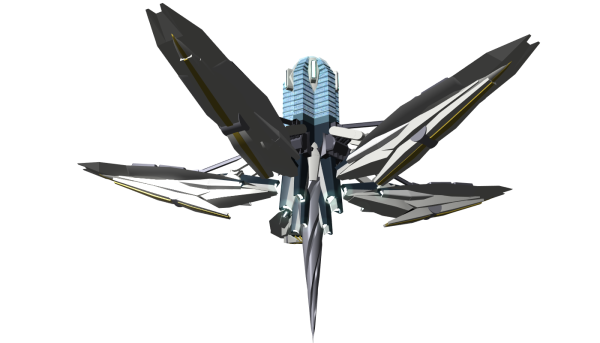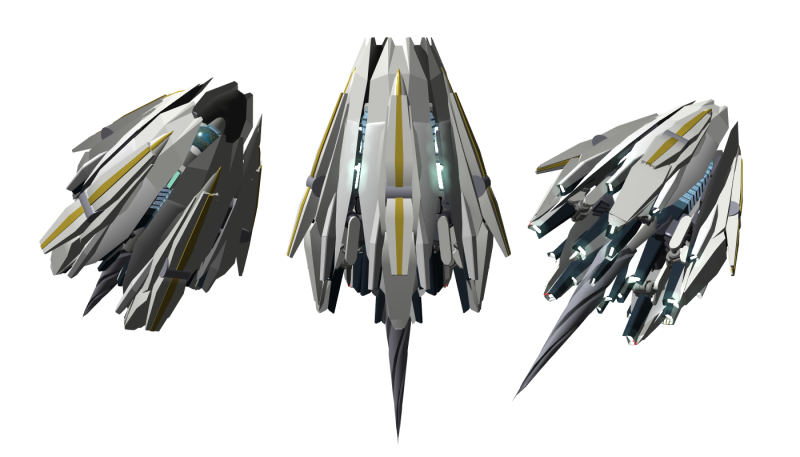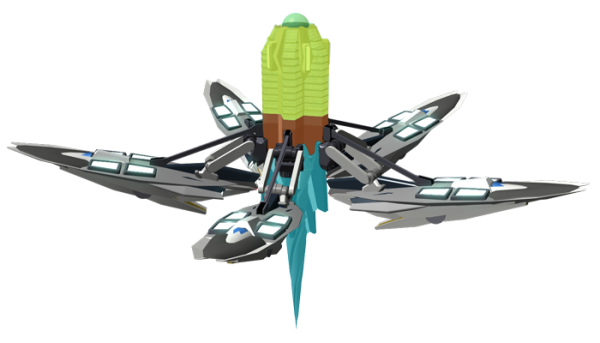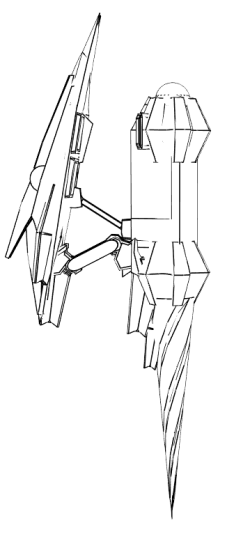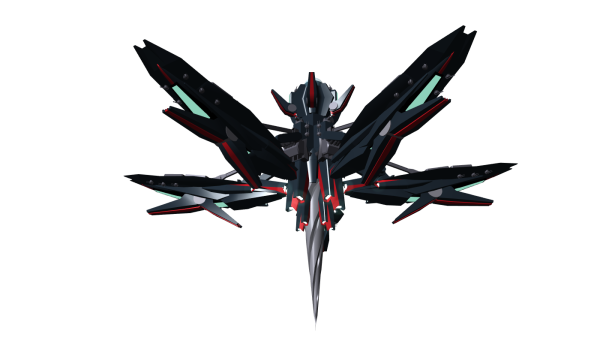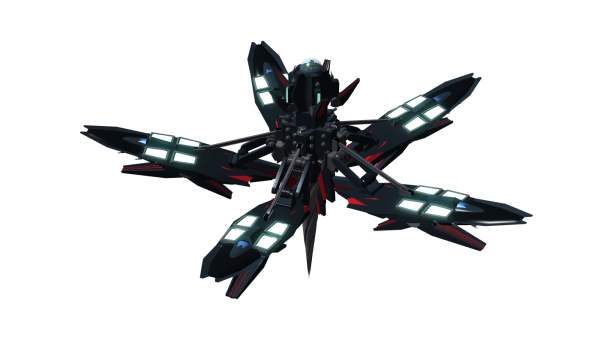Sidebar
Table of Contents
NH-H1 Hibiscus-Class Mobile Space Station
The NH-H1 Hibiscus-Class Mobile Space Station is designed to support corporate and manufacturing interests. Hibiscuses can be pre-built and deployed when necessary, simplifying the process of establishing a new outpost or corporate base within a given system. As with all Noval products, its interior is well-made and generally posh.
An alternate version with heavier armor and weaponry has also been developed based on the same foundation. Dubbed the "NH-H-1A Oculus", it is exclusive to the New Dusk Conclave. Details about this variant are located here.
The "NH-H-1L Castle" is the second alternate version, with an extra emphasis on high-quality interiors and residential spaces. Designed for elite clients, its details can be found here.
Design work for the Hibiscus-class began in YE 41 and it was first entered into production in early YE 43.
About the Station
The NH-H-1 Hibiscus-Class is a deployable space station, intended to simplify the process of expanding corporate frontiers.
It was designed to act as a hub of business, trade, and construction efforts within a system. It has expansive construction capabilities, ample corporate office space, and a unique design that puts the mental health of its residents at the forefront.
Key Features
The Hibiscus-Class' ability to “bloom” sets it apart from other space stations in terms of capability and visual appeal. While “open”, the Hibiscus-Class resembles a futuristic skyscraper in space, surrounded by shipyard and port “petals”. While closed, it resembles a rose or tulip bud with a long thorn for a stem.
One particular feature is the Hibiscus-Class' ability to land planet-side. For clients looking to establish new territory, a localized shipyard and massive business hub can greatly simplify the process of establishing new factories or colonies. When the work is complete, the Hibiscus-Class can return to orbit and act as a intermediate stop between the planet and the rest of the sector. It can also remain in place and act as the center for a new city, providing power, resource management, construction support, and administrative space.
Mission Specialization
As a mobile space station and shipyard, the Hibiscus-Class is especially good at:
- Ship Construction: The Hibiscus-Class' petals contain robust manufacturing systems. Combined with the station's ability to “tidally lock” objects near itself and the dozens of Chromatic Bay Entrances across its surface, the Hibiscus-Class can develop small craft and large ships alike.
- Trade Hub: The Hibiscus-Class' large commercial and business section gives it ample room to support a developing system's economic needs.
- Frontier Development: The Hibiscus-Class' ability to land planet-side and provide construction support to local development efforts makes it an excellent choice for corporations and factions working in the fringes of developed space.
Appearance
A tall central spire makes up the center of the Hibiscus-Class. The upper half of its length resembles a skyscraper of incredible proportion. The top of this half has a number of hangars for craft and a large, dome-covered park area. The spire's lower half is a long spike, with a ring of engines where it meets the spire's central mechanical section.
Extending outward from the central spire are five 'petals', each a huge construction and port assembly. Small craft flurry in and out of the various Chromatic Bay Entrances that cover the tops and bottoms of these petals, unobstructed by impassable bay doors.
The petals are attached to the central spire by massive suspension mechanisms. These mechanisms allow the petals to change orientation.
When stationary, the petals remain open, giving the station an appearance like a flower with a skyscraper jutting out of the top. When in motion, the petals fold in, protecting the inner spire and revealing an additional set of thrusters.
History and Background
The threat of pirates, raiders, and hostile corporate interests means that it can be challenging to build a space station at its intended destination. Without a large fleet to protect such a massive undertaking, the prospect of building a station in relatively unprotected space is a daunting one.
The Hibiscus-Class is Noval's answer to the challenge of developing outposts and shipyards in frontier space. Rather than build a station at its destination, Noval has instead chosen to build their space stations in a defensible location and then relocate them once they can participate in their own defense.
When developing the Hibiscus-Class, Noval began with its own needs. Such a station would need to handle their various corporate interests, act as a local business and finance hub, and provide accommodations and entertainment to its residents. The design would need to take its occupants' mental well-being in mind, providing them a view of the outside universe and the opportunity to enjoy various natural settings.
As with many of their other products, Noval looked to nature for inspiration. A simple flower would become the design focus for the Hibiscus-Class; its ability to protect its delicate components when they were not in use and open up when the time was right was an apt comparison to the space station's needs. The Hibiscus-Class must safeguard its occupants during travel and times of hostility, then “bloom” to allow construction and economic activity to flourish when circumstances improved.
Sunavi Corporation, Noval's primary shipping provider, was one of the first to order this new station design.
Statistics and Performance
The Hibiscus-Class is surprisingly fast for a station of its size until it has “bloomed”. Once deployed, the station is capable of slow movement to maintain its position or relocate- though relocation while unfurled could take days or weeks.
In terms of defensive options, the Hibiscus-Class is well equipped to deal with typical raider craft and ships. Against dedicated military warships, its armaments are likely to be insufficient. For this reason, a small contingent of defensive ships are recommended to remain in system, even after the station has been established.
General
- Class: NH-H1
- Designers: Noval Defense, Space, and Security
- Manufacturer: Noval Heavy Industries
- Fielded by: Noval Heavy Industries, New Dusk Conclave, Independents
- Price:
- NH-H-1(Standard Model): 34,000,000 DS (8,500,000 KS)
- NH-H-1A (Oculus Variant): 39,000,000 DS (NDC Military Only, not for Civilian Purchase)
- NH-H-1L (Castle Variant): 41,500,000 DS (13,375,000 KS)
Passengers
Crew:
- Recommended Crew: 200 (not including drones, such as the iBot)
- Skeleton Crew: 20 (Primarily EVE AIs working in tandem with the King-class Destiny AI)
- Petal/Support Workforce: 800
Accommodations:
- Residential/Trade Employee Capacity: 600,000
- Maximum/Emergency Capacity: 800,000
The majority of the station's functions are managed by onboard Machine Intelligences, which ensure that all station operations and maintenance is carried out efficiently. Internal reporting systems carefully monitor the station's health, people traffic, rations, and other necessities. In the rare event that the MIs cannot make a decision on repair/maintenance, the station's dedicated crew can assist. When not needed in the field, the crew tends to remain within the Hibiscus' administration level.
Much of the Hibiscus' dedicated workforce operates within the petals, including its management personnel. Approximately 150 crew oversee each Petal's port and construction facilities. In this capacity, they act as assistance to the MI's flight control capabilities, manage communications and scheduling, and oversee the progress of work taking place. For especially large projects, two or more Petals will work together.
The Hibiscus' large 'spacescraper' trade decks each contain working space, residential quarters, and support facilities for 6,400 people.
Dimensions
- Hibiscus-class (with Port Petals):
- Width/Diameter:
- Hibiscus-class Diameter, Closed: 2,200 meters
- Hibiscus-class Diameter, Bloomed: 5,975 meters
- Pistil Diameter: 770 meters
- Height:
- Height, Bloomed: 3600 meters
- Height, Closed: 3930 meters
- Pistil(Park): 180 meters
- Pistil(Trade “Spacescraper”): 950 meters
- Pistil(Mechanical and Manufacturing Sector) 930 meters
- Pistil(Landing Spear, Engineering): 1550 meters
- Decks:
- Pistil(Trade “Spacescraper”): 180 (5.175 meters each)
- Pistil(Mechanical and Manufacturing): 150 (6.2 meters each)
- Pistil(Landing Spear, Engineering): 62 (6.2 meters each, average. Only the top quarter of the spear has meaningful floors.)
- Port Petal(s):
- Width: 723 meters
- Height: 383 meters
- Length: 2,580 meters
- Decks: 21 (18 meters each)
Propulsion and Range
- Hyperspace Fold Drive: 0.40 ly/m
- Sublight Engines:
- Closed: .3c
- Bloomed: .1c
- Range: Indefinite, with sufficient maintenance and supplies
- Lifespan: Indefinite, with sufficient maintenance
- Refit Cycle: Noval recommends a thorough maintenance period every 5 years to ensure passenger safety
Damage Capacity
See Damage Rating (Version 3) for a guide to damage ratings to include.
DRv3 Tier: Tier 15 (Station [Heavy Anti-Capital Ship])
Inside the Station
Deck Layout
The Hibiscus-class is composed of a central 'Pistil' and five 'petals' that are radially arranged near the spires midsection. Trade, administration, power, and general operation of the station is conducted within the central spire. Construction and port activities are primarily managed within each petal.
Park (Green)
The topmost portion of the Pistil is a large, domed park. By default, it includes a small, freshwater lake for swimming and recreation, numerous walking paths among trees and landscaped hills, and clean, crisp air. The dome is normally transparent (albeit shielded against harmful radiation or laser weaponry), but can be made to look like the sky from a number of different worlds. A portion of the park's cleaning and maintenance is handled by a periodic, simulated rainfall that is announced well in advance of any occupants becoming wet.
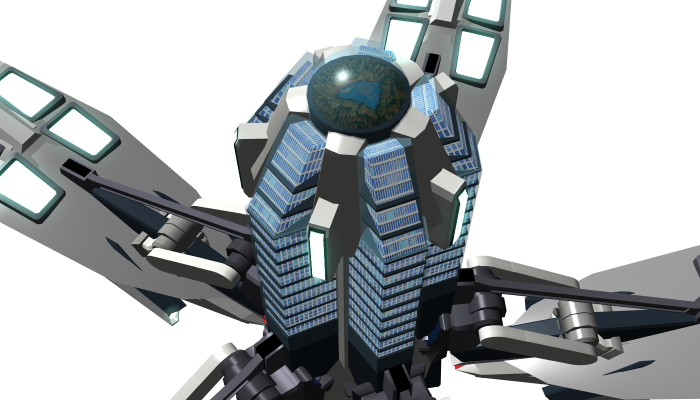
Trade (Yellow)
The trade section of the Hibiscus is where most of its business is carried out. Most of its 180 decks are identical, featuring an outer 'business' ring and an inner 'residential' ring. Combined, each floor is able to act as a campus for a single large business or multiple campuses, typically in a wedge shape, for a number of smaller businesses.
- The business ring is highly configurable, allowing the deck's occupants to set up meeting rooms, hallways, and so on as they see fit.
- The residential ring contains a number of spacious apartments, grocers, restaurant spaces, and food production facilities. It is designed to service high-class clientele, executives, and the everyday needs of the majority of its workers.
- Small craft hangars encircle the top of the trade section, allowing easy access for the tower's more prestigious residents.
- The bottom floor is dedicated to the administration and maintenance of the station itself.
The exterior of the Trade Decks looks like a traditional skyscraper. Tall Transparent Durandium windows span multiple floors, allowing those inside to see out into space. A thicker of layer of transparent durandium sits several meters away from the windows, insulating the building and providing additional protection to its occupent. Designed with the same features as the Hibiscus' park dome, this outer layer can tint and change appearance depending on the wishes of those inside. At the station owner's discretion, the Spacescraper could even appear to reside within a city of their choosing.
Mechanical and Manufacturing (Orange)
The mechanical and manufacturing sector is home to the Hibiscus' primary life support, water treatment, and other support functions. It is also where the majority of component fabrication occurs for the station's various construction projects. This section and the lower section have some degree of overlap due to the station's large engines reaching far into its area.
Engineering and Landing Spear (Blue)
The bottom-most section of the Pistil contains the station's primary drive systems, energy reactors, and the large 'landing spear' that gives the section its particular silhouette. Only the top quarter of this section contains anything resembling decks; the majority is heavily reinforced and thickly plated to provide support for the station when/if it lands.
Petals (No Tint)
Each Petal is a fully-functional port and construction yard. They can construct multiple gunship-sized vessels simultaneously or dozens of smaller craft. Transportation to and from the Petals is done through the large support structures that attach the Petals to the main body. Each of these structures contains four transportation systems, providing swift access to and from the construction yards.
Ship Systems
Armored Hull and Hull Integrated Systems
Much of the Hibiscus-class' exterior is made of Madite, an advanced plastic. The landing spear is also made of madite, thickly webbed on the inside to provide shock absorbance and resilience.
The station's park dome and trade sector 'encasement' are made of thick layers of Transparent Durandium. A fine metallic weave rests between each layer, designed to scatter light and radiation that would be harmful to the station's occupants. This provides some degree of protection against light-based attacks, such as lasers, and allows the station operators to tint the 'glass' should they wish to do so.
Computers and Electronics
A King-class Destiny AI system provides the majority of the sensors, communication, and computing properties required by the Hibiscus-class.
Human interfaces and additional, localized decision making is handled by a number of EVE AI systems, scattered throughout the ship for redundancy. As these AIs are considered to be full citizens of the NDC, they are treated much the same as any other crew member and periodically enjoy 'time off'.
These powerful AIs are able to run the station with minimal, if any, organic support. Ship construction, system regulation, and so on are all carefully and skillfully managed down to the pico-second. As such, the station runs with a very small organic crew compliment, if it has any at all.
Most of the station's repair and maintenance duties are performed by iBot drones.
Construction/Port Facilities
Each of the nearly 2,600 meter long Petals operates as both port and construction yard. Its interior manufacturing facilities can produce and combine everything required for the construction process. Fighters and other small craft smaller than 300 meters can be built within any of the four Chromatic Bay Entrance-protected bays located on the 'top' of the Petal.
For craft larger than 300 meters, it is recommended to halt construction activities within the Petal and dedicate those bays to the construction and transportation of necessary components. These craft are assembled above the Petal, dry-dock style, and are suspended in place by a strong gravity field.
While closed, construction can continue on small craft and ships within the Petals. As much of the construction for larger craft is done above the open petals, such craft must be relocated to a safe distance before the Petal can close. This slows or halts the majority of construction activities on vessels larger than 300 meters.
The majority of each Petal's planning and project management is done in a large, domed area near the four Chromatic Bay Entrances on 'top' of each Petal.
Emergency Systems
Designed and built in a very modular way, the Hibiscus-class can function even after suffering severe damage. All hallways, decks, and compartments can be shut off from the rest of the station in the case of attack or loss of atmospheric pressure. Localized backup generators and air/water recycling systems can support a given deck for at least a week.
In the event of catastrophic damage, each of the station's five Petals can be released from the main body. Their attached command centers and drives allow each Petal to act as an independent vessel. They lack FTL capabilities, but are otherwise reasonably self-sufficient vessels. Re-attaching a Petal after such an event is a difficult matter, as many of the necessary systems will have been damaged in the separation process. A period of at least two weeks are required to affect such repairs.
Landing and Atmosphere Use
In some cases, it may be desirable to bring the station's construction and financial capabilities within a planet's atmosphere. For frontier cities, this could even be a permanent placement. Supported by its large thrusters and gravitic drives, the Hibiscus-class can safely enter and exit a planet's gravity.
The landing process is fairly simple. The station's AI presents a number of suitable landing locations to the station's chief, taking into consideration usable land area, nearby resources, and ground conditions. The AI then ensures that the station remains appropriately aligned as the landing spike is inserted into the surface. The station comes to a rest when its primary thrusters make contact with the ground, where they act as a stabilizing force for the overall structure. At this point, the station can remain safely in position even if it were to lose power.
To reduce stress on the station's components due to the forces of gravity, the various gravitic drives are usually kept engaged at a low level.
As an alternative to landing outright, the Hibiscus-class can remain in a stationary position a few kilometres above a planet's surface. This consumes more energy than a full landing, but may be suitable for planets with an unsuitable ground-level atmosphere.
WARNING: The Hibiscus-class is capable of landing at speeds that are not safe for the local environment. Significant damage to the surrounding area could include a total loss of local flora and fauna, and a flattening of most significant structures within a fifteen kilometre radius from the impact point. For this reason, default landing procedures have been designed to gradually ease the station into place.
Life Support Systems
The Hibiscus-class' primary life support systems are located within the Mechanical and Manufacturing sector. Numerous redundant systems are located throughout the station in the case of a significant failure event.
Each Petal also contains a significant amount of its own life support systems. If detached from the main station, they can provide clean air and water for at least three months. Food and other crucial resources are not, however, present within the Petals in a sustainable way.
Propulsion
A number of NH-M-M5 Magnetically Attenuated Plasma Scramjet "MAPS" drives of varying sizes are located across the Hibiscus-Class' exterior. These drives provide both energy generation and motive power for the station.
While 'closed', the additional drives on the five Petals increase the overall speed of the station by a significant amount. While 'bloomed', these drives are unavailable and the station must rely on its primary drive systems.
Shield Systems
The Hibiscus-class is equipped with a powerful combined shield system, comprised of Electromagnetic and Gravity Shielding.
Weapons Systems
- S6-TLAC "Cavalry": 200, DR 9
NH-H-1A "Oculus" Variant
A militarized version of the NH-H-1 Hibiscus-Class, the Oculus trades much of the Hibiscus-Class' spacious corporate office space for a somewhat reduced profile, improved armor, and stronger defenses. Of particular note is that the Oculas variant uses Madite-C for its outer shell, significantly reducing its sensor signature. An NDC Electronic Camouflage System is included to further reduce the Oculus' signature. While the Oculus can still be detected by sensors, it is much more difficult to get a precise lock on its location or an idea of its exact size compared to the base Hibiscus-class.
Interior
The Oculus variant forgoes most of the Hibiscus-Class' trade decks within the central spire. The Oculus' interior is more spartan compared to the Hibiscus-Class, with a larger focus on military aesthetics. Other than the removal of all but two decks of the trade block and the aesthetic changes, the rest of the Oculus' interior is largely the same as the Hibiscus-Class'.
Weapons Systems
-
- A scaled-up variant of the original weapon, this version of the SHIVA operates much like the original. It draws its power from the station's energy reactors and offsets much, but not all, of its recoil with an advanced dampening system built into the mount.
- S6-TLAC "Cavalry": 200x, DR 9 (Point Defense)
NH-H-1L "Castle" Variant
A variant intended for the wealthy and elite, the Castle is as much a space station as it is a status symbol.
The variant is visually similar to the base Hibiscus-class. Its internals, however, have been given a treatment similar to Noval's "Chairman Package" upgrade. Its various corridors, compartments, and facilities have all been improved to the highest reasonable level. The majority of the station's quarters have been expanded to the size of a posh penthouse, with all the expected amenities.
The visual treatment of the Castle's interior varies based on the customer's requests. It is possible to get a 'futuristic' looking interior, with glowing lights along every corridor, a 'modern' interior with sharp color separation and angular lines, a 'medieval' interior with fabricated stone corridors and tapestries, or any other appearance that the customer might wish.
The station's various AIs are trained to show an appropriate amount of deference and may be customized to some extent to match the overall look and feel of the Castle.
Vehicle Complement
Vehicles of all types regularly come and go through the Hibiscus-Class' Chromatic Bay Entrances. The Station boasts a wide range of support craft, including NH-Y2 Remora-class Utility Craft and NH-Y3 Guppy-class Exploration and Utility Craft for ship handling and construction work. The following are standard issue for all Hibiscus-class variants:
Support Craft
- 20 NH-Y2 Remora-class Utility Craft (4 per Petal, included)
- 40 NH-Y3 Guppy-class Exploration and Utility Craft (10 per Petal, included)
Shuttles
- Dedicated hangar space for 20 Shuttles, none included (2 per Petal, 2 per Pistil Hangar)
Offensive Craft
Each of the 5 Petals can carry:
- 16 Fighter/Mecha Squadrons (12 Fighters/8 Mecha each) or
- 4 Ships up to 300 meters each
While a Petal is loaded for Offensive purposes, it cannot perform construction duties.
OOC Notes
| Products & Items Database | |
|---|---|
| Product Categories | space stations |
| Product Name | Hibiscus-Class Mobile Space Station |
| Nomenclature | NH-H1 |
| Manufacturer | Noval Heavy Industries |
| Year Released | YE 42 |
| Price (KS) | 8 ,500 ,000.00 KS |
Page Tools
Terms of Service - Privacy Policy

